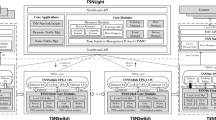Abstract
Voice over Internet Protocol (VoIP) uses packet switching to transmit voice, video, data and chat services. VoIP applications depend upon various speech codecs which vary in speech quality, bandwidth and computational requirements. The key challenges for improving the VoIP Quality of Service (QoS) and Quality of Experience (QoE) is to use best codec by considering network traffic and selecting the optimal hardware. Hardware Calibration is a mechanism to aid service providers by selecting a suitable hardware for Call Manager to transmit different real-time based applications. The paper focuses on proposing a computational model which suggests the most suitable hardware for a specific load handling requirement. The selection of processor is done by taking into consideration the effect of different codecs when it takes calls per second as input and gives output as whichever hardware is recommended for Call Manager to handle different types of applications like Peer-To-Peer (P2P) application, Back-To-Back (BTB) application, enabling voice logging, etc. The emulations demonstrate that the proposed model is suitable for selection of hardware which provides better QoS and QoE for the transmission VoIP based real-time applications. Further, a multi-criteria decision-making method based on Analytic Hierarchy Process (AHP) is also proposed to decide which hardware can be chosen as Call Manager. The results obtained from AHP are used to validate the outcome of the proposed computational model. The computational model is applicable only when the tests are run on particular systems and it suggests the best hardware among them for the particular offered load. However, to suggest the best configuration corresponding to the input load from the possible configurations available in the market, benchmarking is performed. A common scale model for hardware benchmark estimation particularly has been proposed for different scenarios.






















Similar content being viewed by others
References
Goode B (2002) Voice Over Internet Protocol (VoIP). Proc IEEE 90(9):1495–1517
Rosenberg J, Schulzrinne H, Camarillo G, Johnston A, Peterson J, Sparks R, Handley M, Schooler E (2002) SIP: Session initiation protocol. IETF RFC 3261
Rasol M, Al Kasasbeh B, Al Adwan F (2016) An Improved Secure SIP Registration Mechanism to Avoid VoIP Threats. Int J Cloud Appl Comput (IJCAC) 6(2):25–36
Rosenberg J, Schulzrinne H (2002) An Offer/Answer Model with the Session Description Protocol. RFC 3264
Freeman RL (2015) Telecommunication System Engineering, Volume 82, Wiley
Gurbani V, Schulzrinne H, Hilt V (2014) Session Initiation Protocol (SIP) Overload Control. RFC 7339
Takahashi A, Yoshino H, Kitawaki N (2004) Perceptual QoS assessment technologies for VoIP. IEEE Commun Mag 42(7):28–34
Kim K, Choi Y-J (2011) Performance comparison of various VoIP codecs in wireless environments. Proceedings of the 5th International Conference on Ubiquitous Information Management and Communication. ACM
Thompson CA, Latchman HA, Angelacos N, Pareek BK (2013) A Distributed IP-Based Telecommunication System Using SIP. arXiv preprint arXiv:1312.2625
Kim K, Choi YJ (2011) Performance Comparison of Various VoIP Codec in Wireless Environments. Proceedings of ACM International Conference on Ubiquitous Information Management and Communication (ICUIMC 11). Seoul, Korea 1–10
Hole DP, Tobagi FA (2004) Capacity of an IEEE 802.11b wireless LAN supporting VoIP. IEEE ICC, Paris, pp 196–201
Yu J, Ajarmeh A (2008) Design and Traffic Engineering of VoIP for Enterprise and Carrier Networks. Int J Adv Telecom 1(1):27–28
Z. Qiao, L. Sun, N. Heilemann, and E. Ifeachor (2004) A New Method for VoIP Quality of Service Control Use Combined Adaptive Sender Rate and Priority Marking. Proc. IEEE International Conference on Communications (ICC 04), vol. 3, pp. 1473–1477
Naeem MN, Namboodiri (2010) Vinod Namboodiri, Pendse, Ravi Pendse,"Energy implication of various VoIP codecs in portable devices. lcn, pp.196–199, 2010 I.E. 35th Conference on Local Computer Networks
Anouar T, Haqiq A (2012) Performance Analysis of VoIP Traffic in WiMAX using various Service Classes. Int J Comput Appl 20; 29–33
Dagdeviren M, Yavuz S, Kilin N (2009) Weapon selection using the AHP and TOPSIS methods under fuzzy environment. Expert Syst Appl 36(4):8143–8151
FreeSWITCH Home Page [Online]. Available: http://www.freeswitch.org/
Satty TL (1980) The analytical hierarchy process: planning, priority setting, resource allocation. RWS publication, Pittsburg
Chang L-H, Lee T-H, Chu H-C, Lo Y-L, Chen Y-J (2013) QoS-aware path switching for VoIP traffic using SCTP. Computer Standards & Interfaces 35(1):158–169
Shah RD, Singh SK (2016) Media Access Delay and Throughput Analysis of Voice Codec with Silence Suppression on Wireless Ad Hoc Network. Procedia Computer Science 79:940–947
Ansari AM, Nehal MF, Qadeer MA (2013) SIP-based interactive voice response system using freeswitch epbx. Tenth International Conference on Wireless and Optical Communications Networks (WOCN-2013) 1–5
Whittaker E, Robinson G The Calculus of Observations. A trearise on Numerical Mathematics, Book: Blackie and Son Limited, London and Glasgow, Fourth Edition
Acknowledgements
This work is funded and supported by CC&BT, Ministry of Electronics and Information Technology, Government of India, India.
Author information
Authors and Affiliations
Corresponding authors
Rights and permissions
About this article
Cite this article
Kaur, G., Kaur, J., Aggarwal, S. et al. An optimized hardware calibration technique for transmission of real-time applications in VoIP network. Multimed Tools Appl 78, 5537–5570 (2019). https://doi.org/10.1007/s11042-017-5203-y
Received:
Revised:
Accepted:
Published:
Issue Date:
DOI: https://doi.org/10.1007/s11042-017-5203-y




